What are Volts? Amps? Ohms? Watts?
As electricians, it is important for us to understand the fundamentals of electrical theory. In the latest episode of Electrician U, Dustin walks us through Volts, Amps, Watts & Ohms.
🤘⚡️MEMBERSHIP⚡️🤘
JOIN ELECTRICIAN U - become a member and get:
FREE Continuing Education every year
FREE Practice Exams
FREE Monthly Video Courses
FREE Weekly Live Instructor-Led Classes
FREE Monthly Educational Newsletter
Premium Members-Only Content
Private Discord Channel
Monthly Members-Only Discord Chats
Sign up here --- https://www.electricianu.com/electrician-u-membership/
🎧🎹MUSIC AND VIDEO:🎹🎧
https://www.facebook.com/descantmv
🎬✍️ART AND ILLUSTRATION:✍️🎬
https://www.daverussoart.com
Let’s start off with Volts. In an electrical circuit, voltage equals pressure. Low pressure = lower voltage and high pressure = higher voltage. A good analogy to use to try to wrap your head around things is water. Voltage is the same as how hard the water is coming out of the water hose. It can also be called a difference in potential. So, when measuring voltage with your meter you may be able to read 120v or 240v in residential applications or up to 480v in commercial or industrial applications. In electrical calculations, Voltage is written as V or E.
The next term we should cover is Amperage. While voltage is pressure, amperage is current flow. Again, this term is directly proportional. Lower amperage = lower current flow and higher amperage = higher current flow. Going back to our water analogy, amperage could be thought of as how much water is flowing, not necessarily how HARD. In electrical terminology, amperage is written as A or I.
Resistance is the next term to discuss. Resistance is opposition to current flow. Everything electrically that we use has some form of resistance in it. From a light bulb to a vacuum to a television and so on. The interesting thing about resistance is that it slows down current flow to a rate that is usable. Without some form of resistance, the current flow would be so high that we would short our circuit out (this is what happens when we take our load out of a circuit and hook the hot wire straight up to our neutral. BANG!) in electrical calculations resistance is written as R or the omega symbol and is measured in Ohms.
Lastly, we will talk about Watts. Wattage is how much power is being consumed/expended. The lower the wattage the smaller the load is. Take a light bulb for instance. A 60w lamp is not as bright as a 100w lamp. But it’s not just confined to lamps. Every piece of equipment has a wattage rating; toasters, vacuums, tv’s etc.
These simple terms can also be used in conjunction with one another to find one that is missing. Basic Ohm’s law. So, for example, if you knew what voltage your equipment was operating at and how many amps it drew, you could use the Ohms law formula of voltage x amperage = wattage.
We hope this has been helpful in understanding some of the basic but most common terms of electrical theory. Is there a topic you would like to see discussed here on Electrician U? Leave a comment in the comments section and let us know. Please continue to follow Dustin and Electrician U as we are constantly updating our content to assist our followers in becoming the best electricians that they can be.
-
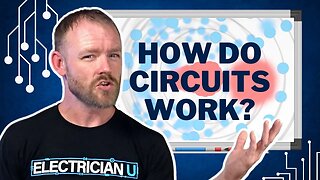 15:04
15:04
Electrician U
1 year agoHow Do Circuits Work? Volts, Amps, Ohm's, and Watts Explained!
298 -
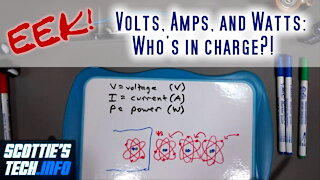 21:10
21:10
Scottie's Tech.Info
2 years agoEEK! #1 - Volts, Amps, and Watts: Who's in charge?
61 -
 17:56
17:56
Scottie's Tech.Info
2 years agoEEK! #6 - AC Power, RMS, & VA vs W
69 -
 20:34
20:34
Vocademy Electronics Technology
1 year agoLesson 1: Conductors, Resistors and Ohm's Law
39 -
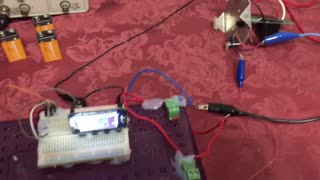 3:21
3:21
Joel Lagace
7 months agoOne Watt Challenge Complete
59 -
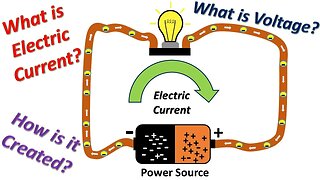 6:39
6:39
Electrical Electronics Applications
1 year agoWhat is Current? Electric Current and Voltage Explained
39 -
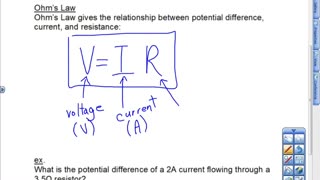 5:01
5:01
PhysicsExplainedWell
3 months agoOhm's Law Lesson
27 -
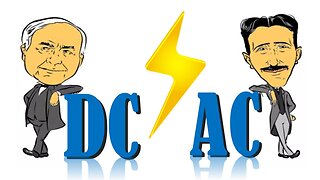 11:32
11:32
Electrical Electronics Applications
1 year agoWhat are AC and DC? Difference Between AC and DC Current Explained
80 -
 1:46
1:46
Larson Electronics - American Made and Manufactured Industrial Lighting and UVC Products
2 years agoWE'VE GOT THE POWER - MUSIC VIDEO Industrial Power Distribution & Lighting Larson Electronics (2021)
118 -
 5:57
5:57
GarageScience
1 year agoHow to Start Electrical Fires ~ Burning/Blowing Up Resistors With Science!!!
12